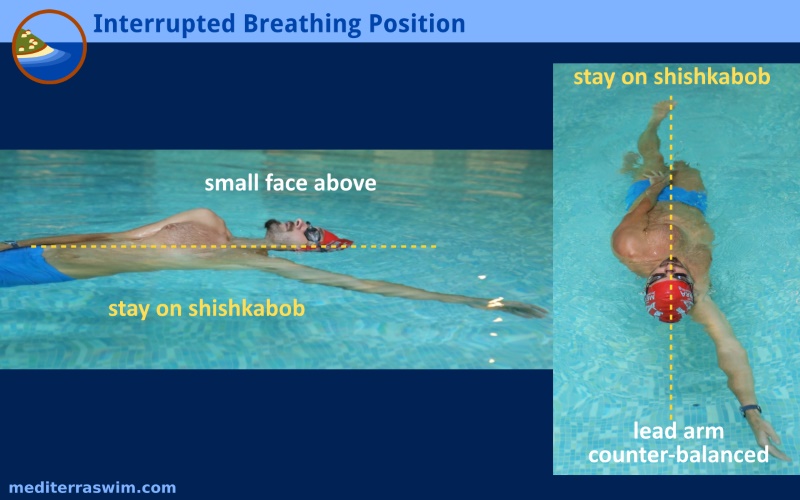by Admin Mediterra | Sep 22, 2020 | Fundamental Skills
Interrupted breathing is a technique you can use while working on other aspects of your stroke with drills or whole stroke. If you would like to focus on this breathing technique directly you may select 2 or 3 cues from the lessons and select a few of the activities listed below. We recommend that you work on turning into Interrupted Breathing on both sides, giving special attention to the side that feels weaker.
Activities
For all of the following activities practice an equal number of times to the LEFT and to the RIGHT.
Push off into Balance Position, then switch to Streamline, then roll to Interrupted Breathing.
Push off into Balance Position, then into Streamline, then roll to Interrupted Breathing, take 3 breaths, then roll back to Streamline.
Take three stroke, then roll to Interrupted Breathing.
Take three strokes, roll to Interrupted Breathing, take 2 breaths, then roll back to Streamline.
Take three strokes, roll to Interrupted Breathing, roll back to Streamline, then take 3 more strokes.
Swim a half length of the pool, and along the way, roll to Interrupted Breathing on the same side, twice.
Swim a half length of the pool, and along the way, roll to Interrupted Breathing, once on each side.
Swim a full length of the pool, and along the way, roll to Interrupted Breathing as needed, on the same side.
Swim a full length of the pool, and along the way, roll to Interrupted Breathing as needed, alternating sides.
by Admin Mediterra | Aug 6, 2020 | Fundamental Skills
Interrupted Breathing Introduction
Once you have learned Streamline Position, we may next introduce you to Interrupted Breathing (a.k.a. Sweet Spot Breathing). Interrupted Breathing is a way of turning to breathe from Streamline Position, while keeping a low-effort position in the water.
The intention behind this breathing position is to ‘interrupt’ the stroke but maintain long, balanced, streamline body, parallel to the surface, that is immediately ready to resume swimming when you are. It is the rest position that requires the least amount of effort to hold – lower heart rate, calmer breathing.
For this reason we teach it as a highly useful, if not essential self-rescue or self-calming position for children and adults, open-water swimmers and triathletes. Counter-intuitively, it works very well in rough water because you are staying down in the water, moving with the surface of the water as it moves, rather than going vertical and trying to lift your head above it, fighting its motion.

Interrupted Breathing is suitable:
- when using during drills that have you pause in Streamline Position
- when doing drills over a full length of the pool and stopping in the middle is disruptive to other swimmers
- when swimming whole stroke in the pool
- when in the middle of a race or rough water and you need to recover your breath and composure
You are encouraged to practice this breathing position and use it frequently because the better you can do this the easier it will be to develop Rhythmic Breathing – the skills for each overlap a great deal.
***
by Admin Mediterra | Aug 6, 2020 | Fundamental Skills
This is an outline of the main drills, cues we may use while introducing you to the Interrupted Breathing skill.
Drills
Here are some demonstrations of how to practice…
Cues
Here are the main cues to help you with critical parts of body position and movement…
- Turn towards open side (‘through the window’)
- Rotate head first – the turn of the head encourages the torso to turn
- Rotate with the Hip
- Keep head underwater as you turn
- Turn on the ‘shishkabob’ spine – keep head perfectly aligned with spine
- Bubble out from the nose until nose and mouth breach the surface
- Keep lead arm anchored deep as is comfortable (in Backstroke Streamline position)
- Keep the smallest face out of the water while breathing
- Relax head and neck once in neutral
- Water should brush the top of your goggles
- Exhale from nose as face rotates under
- Relax head and neck once in neutral

